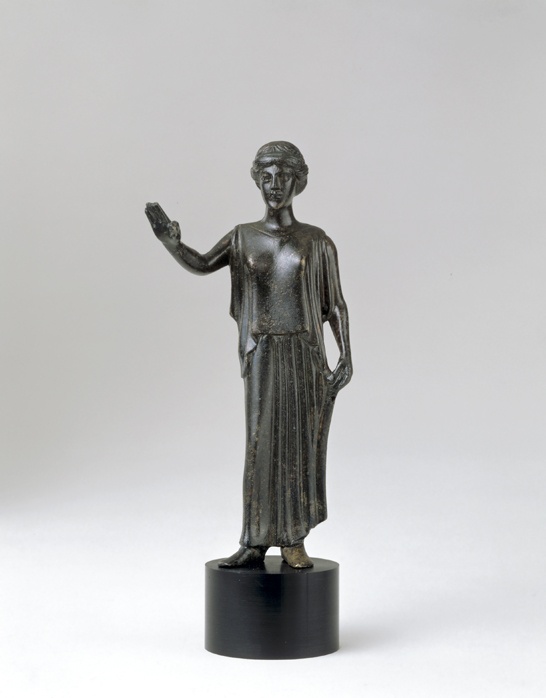
Bronze
H: 13.2 cm
Provenance: no indication
Argive
c. 465 B.C.
Ex collection:
Jacob Hirsch [1]
Sigmund Wassermann, Berlin
M. Ante Mimara
Solid-cast by the lost wax process, finely chased and worked in the cold, highly burnished and polished.
Condition: patina dark, greenish and black brown with gold overtones; specks of cuprite.
Missing [2]: the mirror, its attachment and the circular stand on three lion paws, the tips of the fingers of the right hand with most of the lotus bud held between the index and thumb, as well as the left foot.
The lower left eyelid damaged and a nick to the right side of lower lip; small casting flaws to right foot.
Where the attachment for the cradle rested on the head, hair has been grooved though fortunately without reworking the finely engraved original hair over the rest. The left foot is a modern restoration.
The caryatid mirror statuette dressed in a Doric chiton was still complete in 1921 with its stand, cradle, brace and disc. She stood on a tripod base supported on lion paws. The supporting cradle seems to have been of the arc type [3] surmounted by a disc, apparently plain with a beaded rim. Her Doric chiton at the back falls in regular folds. Her hair is parted frontally and combed back and tucked up in a fillet. She is of extremely fine workmanship.
She has a rather expressive long and narrow oval face that ends in a pointed chin. Her nose is straight and narrow; there is a deep furrow beneath her lower lip.
Still early in the Classical period she represents a persistence of certain archaic characteristics both for the representation, a mirror handle, and for her gesture lifting her chiton with its vertical pleats with her left hand.
Classical is the contrapposto position with the weight on the left leg, the right turned slightly outwards and the very slight incipient turn of her head.
She belongs to a class of mirrors (caryatid mirrors) of which there are a considerable number. These have been variously grouped, but unfortunately with little consensus. For example, R. Tölle-Kastenbein [4] places her within her Toronto caryatid mirror group comprising six Korai and which she ascribes to Athens; whereas L.O. Keene Congdon [5] discusses her within her "Argo-Corinthian - B" group. For certain aspects close parallels are the caryatid mirror in London [6] ascribed to Argos by L.O. Keene Congdon and to Kleonai by E. Langlotz, and the Athens [7] example classified by L.O. Keene Congdon under "Argive - A" and as Corinthian by E. Langlotz. Both these last are grouped under "Athens" by R. Tölle-Kastenbein [8]. However, this author, though recognizing a rapport with Attic statuettes, considers that particularly her hair and her drapery find their closest parallels in Argive works. V.H. Poulsen [9] calls her hairstyle typically Argive.
On view: Antikenmuseum, Basel: 1967-1968
Exhibited and Published:
Meisterwerke griechischer Kunst, cat. no. V 267,
pp. 226, 223 ill.
Hommes et Dieux, cat. no. 117, pp. 195, 197 ill.
Published:
Tölle-Kastenbein, R.: Frühklassische Peplosfiguren (Mainz, 1980), cat. no. 3f, pp. 14, 29-30, 221, pl. 16b, 17c.
Keene Congdon, L.O.: Caryatid Mirrors in Ancient Greece (Mainz, 1981), no. 73, pp. 182-183, pl. 68-69.
Mentioned:
Poulsen, V.H.: Der strenge Stil, ActaArch VIII, 1937, no. 8, p. 20. - Blümel, C.: "Sitzung am 10. Mai 1955", AA 70, 1955, pp. 309-315. - Biesantz, H.: MarbWPr 1957, p. 20. - Thomas, R.: Athletenstatuetten der Spätarchaik und des Strengen Stils (Rome, 1981), p. 155 n. 752. - Brommer, F.: Aus einer früheren Mainzer Sammlung, AA 102, 1987, p. 237 ff. n. 32.
Archaeology Glossary
1 Vente de biens allemands ayant fait l'objet d'une mesure de sequestre de guerre. Collection Hirsch (première vente), Paris, 30 June-2 July 1921, lot 209 pl. II. Hirsch was a dealer, but in view of his importance during the first half of this century and the particular circumstances surrounding this sale, the author has listed him.
2 The ensemble was complete (save for the left foot, see Blümel, C.: AA 70 1955, pp. 310-315, part. ill. 6) still in 1921 but by the time it was sold to Wassermann around 1925, it had been separated from all the now missing parts, a deliberate mutilation by the Paris dealer who had acquired the bronze at the sale, probably thinking thus to make it more valuable as a statuette in its own right rather than just being an element of a mirror.
3 Keene Congdon, L.O.: Caryatid Mirrors of Ancient Greece, p. 112 fig. 20.
4Frühklassische Peplosfiguren, no. 3f, pp. 14, 29-30, 221, pl. 16b, 17c.
5op. cit., p. 183.
6 British Museum 240: Keene Congdon, L.O.: op. cit., no. 45, p. 160, pl. 40; Langlotz, E.: Frühgriechische Bildhauerschulen (Nuremberg, 1927), no. 4, p. 68.
7 National Museum 6197: Keene Congdon, L.O.: op. cit., no. 75, pp. 185-186, pl. 72, 73; Langlotz, E.: op. cit., no. 3, p. 80, pl. 40b.
8 Tölle-Kastenbein, R.: op. cit., no. 1b, pp. 17-18, pl. 2; no. 4f, p. 33, pl. 20.
9 Poulsen, V.H.: ActaArch VIII, 1937, pp. 15-16.